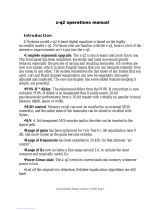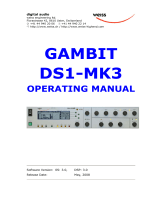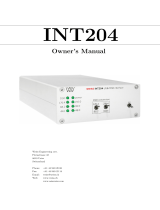WEISS INT202 is a Firewire interface that connects computers to high-quality D/A converters. It features state-of-the-art jitter suppression, up/oversampling, dithering, and digital level control. The INT202 can be used with any computer that has a Firewire port, and it is compatible with both Mac and Windows operating systems.
Here are some of the features and possible use cases of the WEISS INT202:
- It can be used to connect a computer to a high-quality D/A converter, such as the Weiss DAC202 or DAC501. This allows you to listen to digital audio files with the highest possible sound quality.
WEISS INT202 is a Firewire interface that connects computers to high-quality D/A converters. It features state-of-the-art jitter suppression, up/oversampling, dithering, and digital level control. The INT202 can be used with any computer that has a Firewire port, and it is compatible with both Mac and Windows operating systems.
Here are some of the features and possible use cases of the WEISS INT202:
- It can be used to connect a computer to a high-quality D/A converter, such as the Weiss DAC202 or DAC501. This allows you to listen to digital audio files with the highest possible sound quality.



















-
 1
1
-
 2
2
-
 3
3
-
 4
4
-
 5
5
-
 6
6
-
 7
7
-
 8
8
-
 9
9
-
 10
10
-
 11
11
-
 12
12
-
 13
13
-
 14
14
-
 15
15
-
 16
16
-
 17
17
-
 18
18
-
 19
19
-
 20
20
-
 21
21
-
 22
22
-
 23
23
-
 24
24
-
 25
25
-
 26
26
-
 27
27
-
 28
28
-
 29
29
-
 30
30
-
 31
31
-
 32
32
-
 33
33
-
 34
34
WEISS INT202 Owner's manual
- Type
- Owner's manual
- This manual is also suitable for
WEISS INT202 is a Firewire interface that connects computers to high-quality D/A converters. It features state-of-the-art jitter suppression, up/oversampling, dithering, and digital level control. The INT202 can be used with any computer that has a Firewire port, and it is compatible with both Mac and Windows operating systems.
Here are some of the features and possible use cases of the WEISS INT202:
- It can be used to connect a computer to a high-quality D/A converter, such as the Weiss DAC202 or DAC501. This allows you to listen to digital audio files with the highest possible sound quality.
Ask a question and I''ll find the answer in the document
Finding information in a document is now easier with AI
Related papers
Other documents
-
MSB Technology DAC IV plus User manual
-
MyTek Stereo96 ADC User manual
-
 Z Systems z-q2 Operating instructions
Z Systems z-q2 Operating instructions
-
Behringer Ultramatch Pro SRC2496 User manual
-
Behringer Ultramatch Pro SRC2496 User manual
-
Behringer SRC2000 User manual
-
Behringer SRC2496 User manual
-
TC Electronic FILM 6000 MKII SUB-D/XLR Owner's manual
-
 Edelweiss DS1-MK3 User manual
Edelweiss DS1-MK3 User manual
-
Universal Audio 4-710d User manual














































